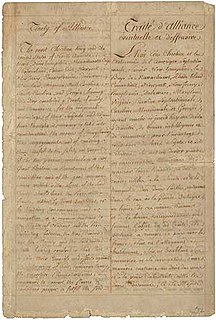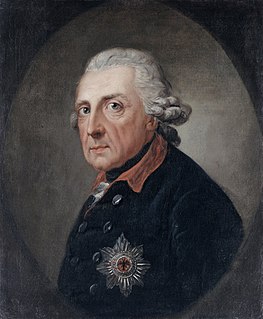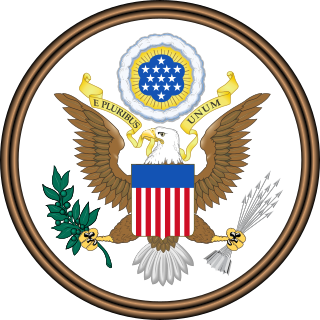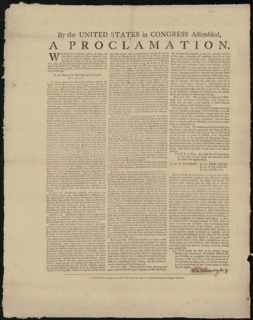 W
WThe Treaty of Alliance, also known as the Franco-American Treaty, was a defensive alliance between the Kingdom of France and the United States of America formed amid the American Revolutionary War with Great Britain. It was signed by delegates of King Louis XVI and the Second Continental Congress in Paris on February 6, 1778, along with the Treaty of Amity and Commerce and a secret clause providing for the entry of other European allies; together these instruments are sometimes known as the Franco-American Alliance or the Treaties of Alliance. The agreements marked the official entry of the United States on the world stage, and formalized French recognition and support of U.S. independence that was to be decisive in America's victory.
 W
WThe Treaty of Amity and Commerce established formal diplomatic and commercial relations between the United States and France during the American Revolutionary War. It was signed on February 6, 1778 in Paris, together with its sister agreement, the Treaty of Alliance, and a separate, secret clause allowing Spain and other European nations to join the alliance. These were the first treaties negotiated by the fledgling United States, and the resulting alliance proved pivotal to American victory in the war; the agreements are sometimes collectively known as the Franco-American Alliance or the Treaties of Alliance.
 W
WThe Treaty of Amity and Commerce between the Kingdom of Prussia and the United States of America was a treaty negotiated by Count Karl-Wilhelm Finck von Finckenstein, Prussian Prime Minister, and Thomas Jefferson, United States Ambassador to France, and signed by Frederick the Great and George Washington. The treaty established a commercial alliance between the Kingdom of Prussia and the United States of America and was the first one signed by a European power with the United States after the American Revolutionary War. The Kingdom of Prussia became therefore one of the first nations to officially recognize the young American Republic after the Revolution. The first nation to recognize the US was Sweden, who during the Revolution signed a Treaty of Amity and Commerce.
 W
WThe Articles of Confederation and Perpetual Union was an agreement among the 13 original states of the United States of America that served as its first constitution. It was approved after much debate by the Second Continental Congress on November 15, 1777, and sent to the states for ratification. The Articles of Confederation came into force on March 1, 1781, after ratification by all the states. A guiding principle of the Articles was to preserve the independence and sovereignty of the states. The weak central government established by the Articles received only those powers which the former colonies had recognized as belonging to king and parliament.
 W
WThe Bank of North America was the first chartered bank in the United States, and served as the country's first de facto central bank. Chartered by the Congress of the Confederation on May 26, 1781, and opened in Philadelphia on January 7, 1782, it was based upon a plan presented by US Superintendent of Finance Robert Morris on May 17, 1781, based on recommendations by Revolutionary era figure Alexander Hamilton. Although Hamilton later noted its "essential" contribution to the war effort, the Pennsylvania government objected to its privileges and reincorporated it under state law, making it unsuitable as a national bank under the federal Constitution. Instead Congress chartered a new bank, the First Bank of the United States, in 1791, while the Bank of North America continued as a private concern.
 W
WThe Flag Acts are three laws that sought to define the design of the flag of the United States. All the submitted suggestions were remarkably short, the shortest being a sentence of 31 words, and the longest being a title and two sentences of 117 words.
 W
WThe Treaty of Fort Pitt, also known as the Treaty With the Delawares, the Delaware Treaty, or the Fourth Treaty of Pittsburgh, was signed on September 17, 1778, and was the first written treaty between the new United States of America and any American Indians, in this case the Lenape. Although many informal treaties were held with Native Americans during the American Revolution from 1775 to 1783, the only one that resulted in a formal document was signed at Fort Pitt, Pennsylvania, now the site of Downtown Pittsburgh. It was essentially a formal treaty of alliance.
 W
WThe Treaty of Fort Stanwix was a treaty finalized on October 22, 1784, between the United States and Native Americans from the six nations of the Iroquois League. It was signed at Fort Stanwix, in present-day Rome, New York, and was the first of several treaties between Native Americans and the United States after the American victory in the Revolutionary War.
 W
WThe Great Seal is a principal national symbol of the United States. The phrase is used both for the physical seal itself, which is kept by the United States Secretary of State, and more generally for the design impressed upon it. The obverse of the Great Seal depicts the national coat of arms of the United States.
 W
WThe Land Ordinance of 1785 was adopted by the United States Congress of the Confederation on May 20, 1785. It set up a standardized system whereby settlers could purchase title to farmland in the undeveloped west. Congress at the time did not have the power to raise revenue by direct taxation, so land sales provided an important revenue stream. The Ordinance set up a survey system that eventually covered over 3/4 of the area of the continental United States.
 W
WIn December 1777, the Moroccan Sultan Muhammad III included the United States in a list of countries to which Morocco’s ports were open. Morocco thus became the first country whose head of state publicly recognized the newly independent United States.
 W
WThe Northwest Ordinance enacted July 13, 1787, was an organic act of the Congress of the Confederation of the United States. It created the Northwest Territory, the new nation's first organized incorporated territory, from lands beyond the Appalachian Mountains, between British North America and the Great Lakes to the north and the Ohio River to the south. The upper Mississippi River formed the territory's western boundary. Pennsylvania was the eastern boundary.
 W
WThe Olive Branch Petition was adopted by the Second Continental Congress on July 5, 1775, and signed on July 8 in a final attempt to avoid war between Great Britain and the Thirteen Colonies in America. The Congress had already authorized the invasion of Canada more than a week earlier, but the petition affirmed American loyalty to Great Britain and beseeched King George III to prevent further conflict. It was followed by the July 6 Declaration of the Causes and Necessity of Taking Up Arms, however, which made its success unlikely in London. In August 1775, the colonies were formally declared to be in rebellion by the Proclamation of Rebellion, and the petition was rejected by the British government; King George had refused to read it before declaring the colonists traitors.
 W
WThe Petition to the King was a petition sent to King George III by the First Continental Congress in 1774, calling for repeal of the Intolerable Acts.
 W
WRatification Day in the United States is the anniversary of the congressional proclamation of the ratification of the Treaty of Paris, begun a year after on January 14, 1784, at the Maryland State House in Annapolis, Maryland by the Confederation Congress.
 W
WThe Treaty of Watertown, the first foreign treaty concluded by the United States of America after the adoption of the Declaration of Independence, was signed on July 19, 1776, in the Edmund Fowle House in the town of Watertown, Massachusetts Bay. The treaty established a military alliance between the United States and the St. John's and some of the Mi'kmaw bands against Great Britain for the early years of the American Revolutionary War.